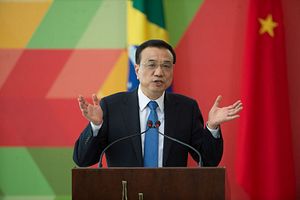Chinese Premier Li Keqiang wrapped up a nine-day tour of South America yesterday after visiting Brazil, Colombia, Peru, and Chile. As I wrote earlier, Li’s trip — his first to the region since assuming office in March 2013 — was largely focused on trade and economic relations.
In Brazil, Li signed $53 billion worth of deals for Chinese investment in the country, mostly involving commodities and infrastructure, including a reported $10 billion in credit for Petrobras, Brazil’s state-owned oil company. In both Peru and Brazil, Li talked with his counterparts about moving forward on an ambitious plan to create a trans-continental railroad, linking Brazil’s Atlantic coast with the Pacific Ocean via Peru. The three countries have agreed to conduct a feasibility study for the proposed railroad, which was also discussed during President Xi Jinping’s trip to Brazil last year.
In Colombia, where Li became the highest-ranking Chinese official to visit since the two sides established diplomatic relations in 1980, the possibility of opening free-trade agreement talks was discussed. Li also signed a deal that would have China create a development plan for the Colombian port city of Buenaventura.
In Chile, the biggest deliverable was a currency swap arrangement that will allow China and Chile to exchange 2.2 trillion pesos ($3.6 billion) over the next three years. Chile was also the site of Li’s big speech for the tour, an address in front of the UN Economic Commission for Latin America and the Caribbean (ECLAC) in Santiago.
In his speech, Li laid out “four pillars” for China-Latin America cooperation: “cementing traditional friendship and mutual trust, upgrading win-win cooperation, expanding people-to-people exchanges and improving overall cooperation mechanisms.” More concretely, Li urged more industrial capacity cooperation between China and Lain America. “China has cost-effective equipment and technology while Latin America needs infrastructure construction and industrial upgrading,” Li said. While in Brazil, Li announced a $30 billion fund to promote China-Latin America cooperation on industrial capacity and manufacturing.
Industrial cooperation is a mainstay of China’s relationship with Latin America. According to Xinhua, China’s contracts for projects in Latin America, “including projects in natural gas, pipelines, power plants, roads, sea ports, housing, telecommunications and railways,” were worth over $110 billion by the end of 2014.
Still, concerns linger. For one thing, a study from the Brazil-China Business Council found that only around one-third of China’s promised investments from 2007-2012 were ever actually made. Other analysts point to a trade imbalance, where China imports natural resources from Latin America and exports manufactured goods. In addition to the economic consequences of unbalanced trade, that arrangement also leaves regional economies especially vulnerable to a slowdown in Chinese demand for raw materials — a danger that is already affecting Latin American economies.
China is aware of such concerns, which is why part of Li’s diplomacy during his tour involved calls for “an updated model of Sino-Latin American cooperation.” As Xinhua put it, “The trade structure for run-of-the-mill industrial products and raw materials doesn’t support sustainable development, so both sides need to join hands in pursuing industrial modernization and a transformation of their economic growth models.”

































